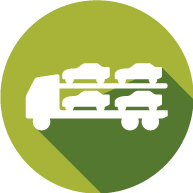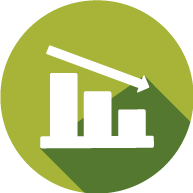Since the resolution of the Paris Agreement to limit global warming to 2°C, the importance of sustainability and environmental protection has grown steadily. The Fridays for Future movement has also drawn attention to this goal.
2021 demonstrated the critical role played by the logistics industry. The Covid pandemic highlighted the system relevance of ports, road, and rail. The logistics industry provides a key link between producers, retailers, and consumers. It also offers many additional services related to production. Apart from classical forwarding, other major activities are logistics services for the delivery, production, and distribution of goods. All this makes the logistics industry a crucial lever for climate protection.
Jump to:
Green Rail transport: BLG RailTec in Falkenberg
More:
sustainable logistics buildings: the C3-Bremen
We take a holistic view of the entire logistics chain, including all suppliers. This reveals a whole range of opportunities for sustainable logistics strategies. The result? We can save not only resources, but also costs across the board: in goods transport, construction and operation of buildings, storage and conveyor technology, through to packaging and loading equipment.
Supply chains play an important role in sustainable logistics. Customers increasingly demand sustainable transport solutions. What's more, digitalization and autonomous driving offer exciting opportunities for the logistics industry. Digital tools and platforms are effective drivers that can help save resources. Simultaneously, energy efficiency cuts costs. That is ever more important considering the current spiraling costs for energy and fuel.
BLG LOGISTICS is committed to cutting emissions along our supply chain by 15%. Included here are e.g. emissions from business trips and diesel consumption by our subcontractors. We want to establish and promote sustainable business practices not only at BLG, but also along the entire supply chain.
As land and energy costs rise and space for logistics buildings becomes scarce, a green approach to infrastructure, construction, and operation of warehouse and logistics centers offers huge potential for cost and resource savings as well as emission reductions from innovative solutions and smart processes.
We pool all our efforts to become a climate-neutral logistics company in our mission climate policy for climate protection.
We aim to achieve zero increase in atmospheric pollution in global terms from our business activities and sustainable logistics operations. To do this, we will slash our own emissions by 30% in absolute terms and cut emissions generated outside the company by 15%.
Additionally, we will compensate all other emissions to achieve climate neutrality by 2030.

LED lighting for 2.6 million square meters
We are successively converting all our buildings to LED lighting. So far, this saves the company 2.4 million kWh of electricity per year. Nine buildings in our logistics center in Bremen have been converted to the new technology. The parking lots and garages at the Autoterminal in Bremerhaven– the largest of its kind in Europe – are already illuminated by LED lighting. Here alone, the company saves 1.3 million kWh annually, which is equivalent to around 400 metric tons of CO2.

Green rail
In Germany and Austria, BLG AutoRail already uses 100% green electricity in rail transport.

Photovoltaic power saves energy costs
Cutting carbon emissions is one element in achieving our climate goals, generating our own electricity is another. Photovoltaic modules on the roofs of our logistics buildings generate solar energy in the form of electricity. BLG LOGISTICS uses solar power and generates its own electricity from regenerative sources at several locations. We increasingly cover our additional demand by purchasing green electricity.

In 2019, we installed a photovoltaic system on the roof of the Technical Center at the BLG AutoTerminal in Kelheim. The system covers an area of 430 m² and has a capacity of 74 kWp. BLG uses 100% of the electricity generated for its own operations. In 2020, a further system with ten times the capacity was commissioned at our Waiblingen location. The solar power it generates now supplies half of the electricity required at the facility. Together, the two systems provide 345,000 kWh of energy, which saves 76 metric tons of CO2. Our C3 building currently under construction in Bremen will feature the largest photovoltaic system, with a capacity of 9,800 kWp.

100% of our trucks comply with the EURO 6 standard
BLG LOGISTICS regularly upgrades its fleet: 100% of our fleet of 187 trucks in Germany comply with the EURO 6 standard. The newer trucks not only emit less nitrogen oxide, but also consume less fuel. That cuts both costs and CO2 emissions. The average diesel consumption of BLG AutoTransport was 29.4 liters per 100 km, which was once again lower than the previous year's figure.

240 forklifts with lithium-ion batteries + 37 fuel-cell forklifts
We regularly renew our forklift fleet with the latest models. BLG LOGISTICS is increasingly relying on lithium-ion batteries and already uses 37 hydrogen-driven forklifts.

AI and new planning tools reduce carbon emissions
BLG LOGISTICS is conducting several research projects on the use of articial intelligence to cut our CO2 emissions and make our logistics even more sustainable. For example, we're examining how to avoid zero-load travel and reduce driving at the terminal. This requires optimization of the planning processes to ensure best-possible capacity utilization.
Using AI, we can bring all the parameters together and create the basis for automated tour planning. The AI tool should also be capable of recognizing patterns in the traffic flows so that it can e.g. suggest to customers the best day for collection and can also optimize the entire network.
Reducing zero-load travel and optimizing capacity utilization planning will significantly improve our carbon footprint in this area.
"green rail" transport. It's a well-known fact that every kilometer of rail track actively vontributes to climate protection
That is one reason why long-distance traffic is increasingly moving onto rails. Another goal is longer freight trains. We need innovative solutions for this. The key is digital automated coupling (DAC). This innovation ensures faster formation of freight trains and automatically connects freight cars as well as their electricity, data and compressed-air lines. The data is transmitted directly to the locomotive. Today, train length is limited by the maximum coupling hook load. Digital automated coupling is designed for a greater coupling hook load and, together with electropneumatic brakes (ep brakes), it enables much longer trains of more than 1,000 meters. BLG RailTec is at the forefront of these developments and is cooperating with the Technical University of Berlin during the test phase. In Europe alone, 700,000 freight cars need to be retrofitted to take advantage of this technology. Currently, the team in Falkenberg is gaining the necessary expertise.
Sustainability in rail transport through innovation and digitalization
An important step on the way to sustainable rail logistics is digitalization of the processes. This will help us to involve all parties throughout the logistics chain. A targeted data flow will allow access to core parameters at all times to ensure smooth order processing. For example, DB Netz is developing a blockchain for its rail traffic network. The digital system will map not only passenger traffic, but also the operational train scheduling of the rail companies.
Why automobile logistics is predestined for rail transport
For all participants in any logistics chain, rail transport is a fundamental contributor to positive development of their carbon footprint. Each train can transport more than 200 cars, removing a massive amount of trucks from the road. Especially in multimodal transport, rail is the ideal solution for longer national routes from around 300 km. Shorter distances tend to be covered by road. The last mile to a loading or unloading location almost always represents a bottleneck because often no electric overhead lines are installed and loads have to be transferred to diesel trains or trucks. There is plenty of potential for improvements here through coordinated operations by automobile manufacturers and logistics companies, and the use of multimodal terminals for handling at the interface between long-distance transport by rail and shorter-distance transport by road.
Green electricity for rail transport
Using electricity from renewable sources for rail transport is another major step towards an improved carbon footprint and green, low-carbon transport logistics. In Germany and Austria, BLG AutoRail already uses 100% green electricity in rail transport. We regularly ask rail transport companies to provide evidence about whether they purchase green electricity.
How using circular concepts to reduce zero-load trips can contribute to more sustainable rail transport
It makes sense to reduce zero-load trips in rail traffic. The way to do this is through cooperation with third-party rail logistics providers to devise more circular concepts and check that the legal and operational framework conditions are suitable. Here's one example: Container transports with the China Railway Express on the New Silk Road between Europe and China operate once a week within a fixed time slot. This is a major component of the ACFTA (ASEAN-China Free Trade Agreement) and the trade activities it governs. What's more, an integrated rail network can deliver logistical and cost benefits. The possibilities include not just mixed trains in normal combined transport, but also transports to the same region by different logistics companies for various contractors. There is increasing cooperation between logistics partners, which supports sustainable rail logistics.
Employee mobility - on the move with lower emissions. Our goal: 10% reduction in carbon emissions per employee by 2024
Sustainable mobility means meeting today's mobility needs with long-term green solutions in the future. Above all it's about reducing emissions as well as resource consumption. Also important are optimal development and utilization of local public transport. What's more, green mobility helps improve general standards of living. Reducing noise and exhaust gas emissions also offers health benefits.
To improve sustainability in employee mobility, BLG LOGISTICS aims to reduce carbon emissions per employee by 10% by 2024. Our focus is on the emissions generated by commutes. We also conduct annual surveys to find out how our employees tackle their personal mobility needs. Based on this data, we have identified various approaches and derived efficient measures that cut costs and simultaneously benefit the climate.
At the same time, we examined climate-damaging emissions generated by our fleet, business trips, shuttle services, commutes, deliveries, and customer traffic.









